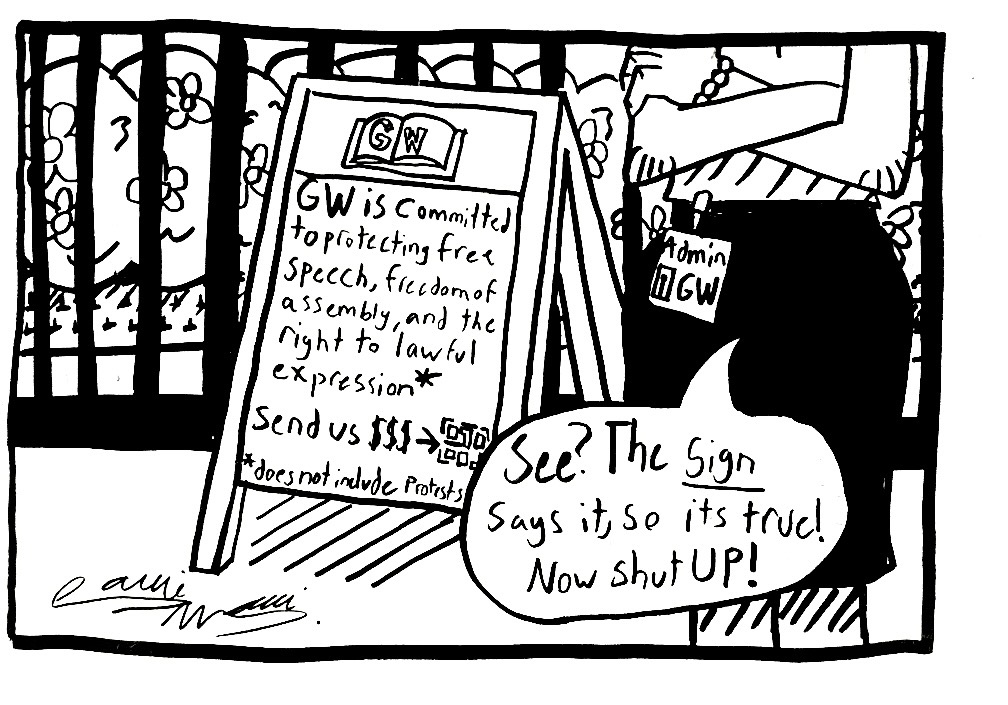Around this time last year, University Yard was buzzing. People were throwing around frisbees, playing catch with friends and hammocking. But after the installation of the tall, black fences barricading U-Yard — the greener part of campus — the once-vibrant campus spot has become near desolate.
It has been five months since officials installed the fences around U-Yard, following the clearing of the pro-Palestinian encampment in May, and as we approach the end of the semester, it’s hard to ignore. Officials said the fences will remain for part of the first semester while officials look for structures that “aesthetically integrates with the campus,” but the arrival of the new fences was delayed due to Hurricane Helene. We don’t know when the fences will come down for good. Officials have also introduced a schedule for the fences to open at 6 a.m. and close at 11 p.m. But the presence of the fences has in turn become a symbol of a tense environment on campus that, at times, physically or symbolically blocks students from using the space.
The University hastily put up the fences after the Metropolitan Police Department cleared the encampment. As the fences remained, officials said “several factors” contributed to their placement, including “fostering a safe campus event” and “maintaining the operation” of GW’s programming. Officials added that “security experts” endorsed the fencing to “better control access” of the space. But the fencing doesn’t feel as if it’s protecting us from unsafe protests — it makes the campus feel ugly and inapproachable. A student earlier this month said, the fencing “shows the school’s apathy and inability to work with students.”
University President Ellen Granberg said at the beginning of the month that we should “recommit to caring for one another and nurturing a shared community,” but it’s particularly difficult to nurture a community when a fence comes between students and one of the few green spaces on campus where they can come together. GW isn’t like other universities with endless greenery, and as some students described it, seeing the fences up made a once lively spot feel dejected.
The University hasn’t particularly acknowledged and been transparent about how they erected a fence in one of the most community-like spaces on campus. GW hasn’t widely disseminated the U-Yard fencing schedule, outside of placing it on their website, or listed alternative spaces for students to congregate. It also appears that at times, officials haven’t been completely transparent about how these spaces can be booked for events. Earlier this month, students from the Student Coalition for Palestine said they booked U-Yard at 7 p.m. to hold a vigil to mourn those killed in Lebanon and Palestine, but the space’s fences were closed before 7 p.m., though per the schedule, it closes at 11 p.m. Officials didn’t like the idea of so many congregating and were concerned about “outside agitators.”
Fenced-off campus green spaces isn’t an exclusively GW issue. Other universities have also blocked off their green spaces where encampments previously took place, setting up the fences after the police cleared the encampments. Drexel University has had fences around Korman Quad since Sept. 9, in addition to the University of Pennsylvania who — like GW — quickly put up fences after the clearing of their encampment. Across the pond, Oxford University put up a fence around the Museum of Natural History as well. Like GW, other universities say safety is their main reason for these fences, but it’s time to truly analyze and understand what these fences say to their respective university communities.
Fences and walls already carry the underlying tone of trying to separate or make a distinction. They’re used to signal one’s property. But the main reasoning is always division — dividing up your property, separating something or someone from others. How is keeping up this fence “holding a community together” when the general purpose of a fence is to divide?
The encampment was already a very serious situation that carries a lot of emotional charge for some students, staff and faculty. Whether it’s from the protesters who were there for around nearly 14 days, the protesters who were pepper sprayed and even arrested, or the people who witnessed this encampment, it has weight. And it’s harder to come together as a campus when GW keeps up a fence — a reminder of everything that happened in the protest, amplifying the emotions of the GW community, including the shortcomings of requesting MPD to clear the encampment and the lack of transparency from GW officials when poorly handling the protest last semester. Granberg says we have to “move forward,” and have “renewed commitment,” but that can’t be done with a fence that has made U-Yard mostly empty.
But as long as that fence is still up, the chances of seeing our student body and community reading and playing in U-Yard seem slim. And the editorial board can only hope that GW will put down the fences so that students can enjoy the shared space and so that campus can heal.
The editorial board consists of Hatchet staff members and operates separately from the newsroom. This week’s staff editorial was written by Opinions Editor Andrea Mendoza-Melchor, based on discussions with Research Assistant Carly Cavanaugh, Culture Editor Nick Perkins and Sports Columnist Sydney Heise.





